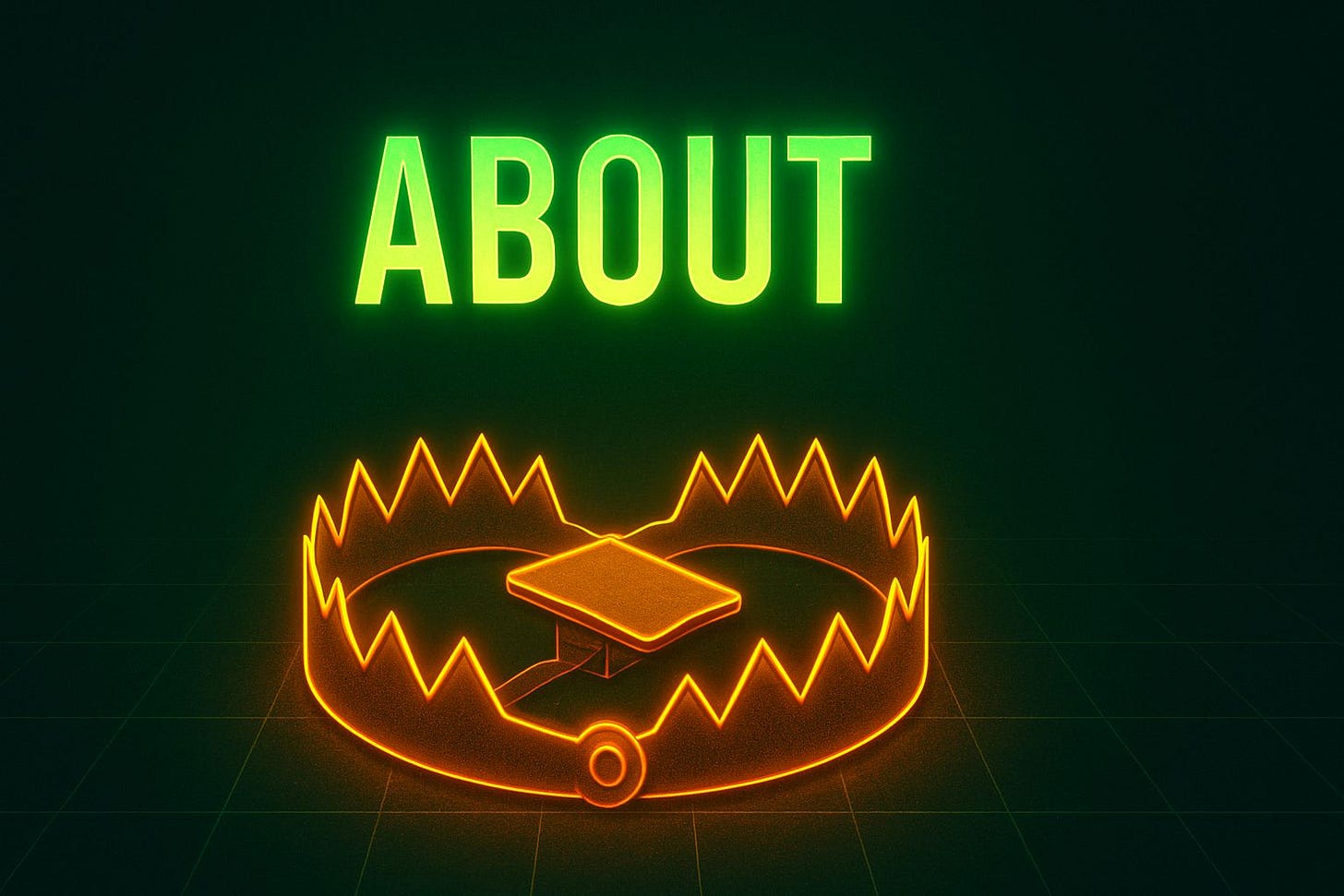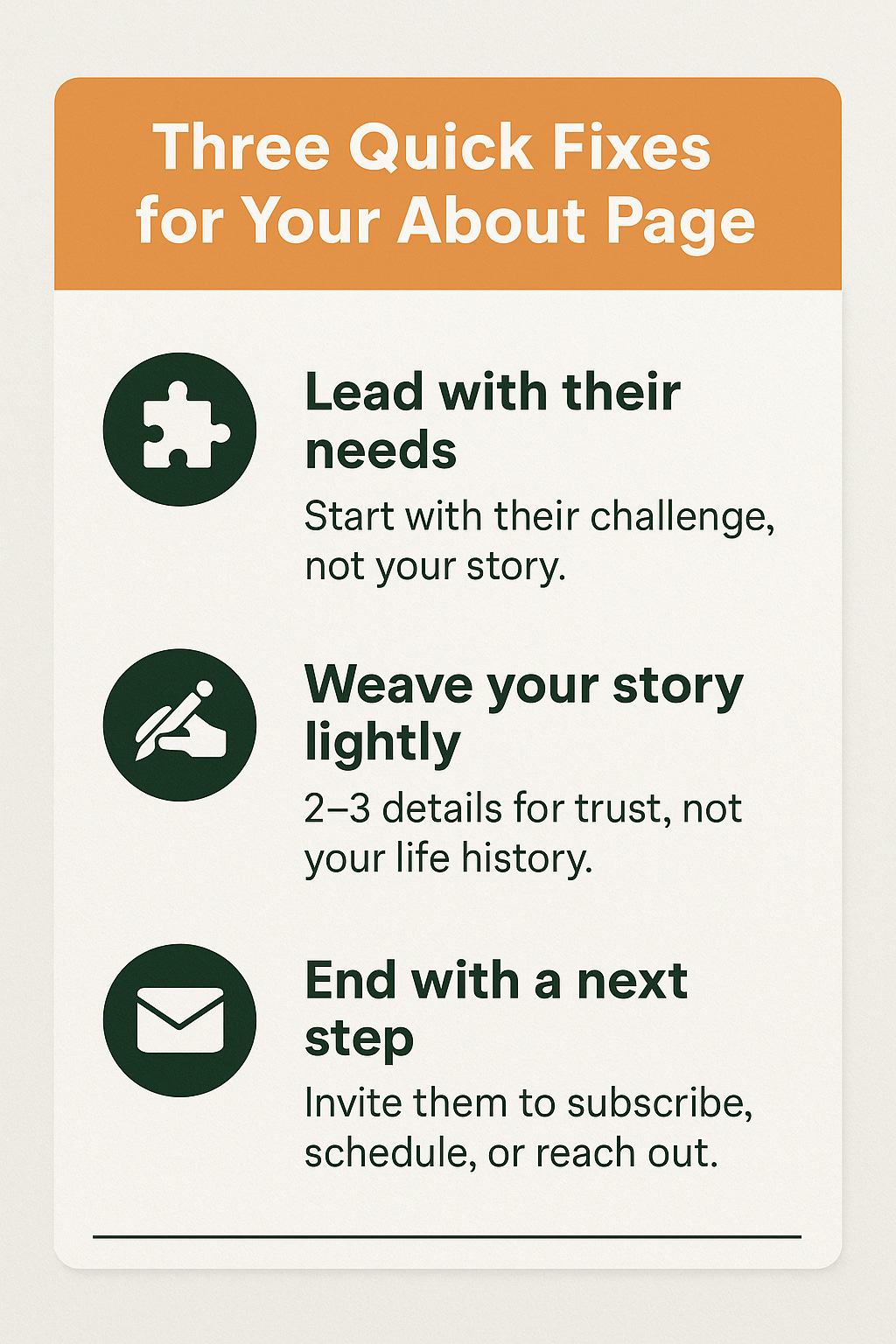Free Your Website From The About Page Trap
Stop writing a résumé. Start showing visitors why you’re the right fit.
Are you caught in the About page trap?
It’s the mistake that makes your page sound like a résumé instead of a reason to stick around. And when that happens, visitors leave before they ever see how you can help them.
Think about the fancy résumé version, the one that opens with your accomplishments and accolades. Or the LinkedIn-style rundown of your career history. If that sounds like your About page, you’re already in the trap.
The good news? It’s an easy fix. Because your readers care less about who you are, and more about what you can do for them.
The About Page Trap
Here are a few signs you’ve fallen into the About page trap:
It opens with a long backstory about you, your product, or your company.
It reads like a list of credentials.
It leans on a generic mission statement.
If that sounds familiar, it’s understandable. You want to put your best foot forward. You want people to know who you are and what you’ve accomplished.
The problem? That’s not what an About page is for. Leading with you disconnects from the reader, because they don’t see why it matters to them. They skim, don’t spot anything that speaks to their concerns, and move on.
And here’s the tough part: you’ll never know they were there, or why they didn’t engage.
An effective About page isn’t really about you at all; it’s about the person reading it.
Flip the Focus
The basic rule of thumb for your About page copy is simple: write as if the reader is asking, “What’s in it for me?” Keep that in mind, and you’ll stay on track.
Here’s a framework to do that:
Start with their problem or goal
Position yourself as the guide, not the star
Share just enough of your story to build trust
👉 Take Sarah, a business coach. Notice the difference:
Before
About Sarah
“I am a certified business coach with over 10 years of experience. I graduated from UCLA with a degree in Business Administration in 2012 and worked at three Fortune 500 companies before launching my own practice in 2018.
My credentials include:
ICF-certified Professional Coach (PCC)
MBA from Stanford Graduate School of Business
Former Senior Manager at McKinsey & Company
Speaker at 15+ industry conferences
Published in Forbes, Entrepreneur, and Inc. Magazine
I specialize in helping small-business owners scale their operations through strategic planning and operational efficiency. My methodology combines lean startup principles with evidence-based coaching techniques.”
After
About Sarah
“You started your business with a vision, not to drown in spreadsheets at 11 PM on a Friday. I help founders like you get out of the weeds and back to work that lights you up. After coaching 200+ entrepreneurs, I’ve learned your business doesn’t need another framework, it needs clarity on what moves the needle (and permission to drop the rest).
Maybe you’re hitting six figures but stuck working 60-hour weeks. Or you’ve got a waitlist you can’t fulfill because you’re still doing everything yourself. I’ve been there, running on caffeine and conviction, convinced that working harder was the only way forward. It wasn’t. And it isn’t for you either.
Together, we’ll cut through the noise, find your real bottlenecks, and build systems that scale without burning you out. Less hustle theater, more strategic growth.
The short version: Former McKinsey consultant turned business coach. I’ve helped founders add six figures in revenue while reclaiming their weekends. Also, a Stanford MBA—but that matters less than knowing what it’s like to cry over QuickBooks.”
Key differences:
The “before” leads with credentials; the “after” leads with the reader’s pain.
The “before” lists achievements; the “after” shows empathy and results.
The “before” explains methodology; the “after” positions Sarah as a relatable guide.
The “after” still includes credentials, but only after trust is built.
Credentials are impressive, but they don’t matter until the reader believes you understand them. The second version puts the reader at the center, then brings Sarah’s credibility in as proof.
Now, let’s talk about how you can apply this same shift to your own About page.
Three Fixes to Try Right Now
If your About page feels more like a résumé than a connection point, here are three quick fixes you can make this week:
1. Lead with their needs.
Instead of opening with your backstory, start by naming the challenge your clients face. For example: “Running a solo business can feel like juggling ten jobs at once.”
Right away, your reader knows you get what they’re up against, and they’ll keep reading to see how you can help.
2. Weave your story lightly.
Pick two or three details that make you relatable and trustworthy. That’s enough to build credibility without putting the spotlight solely on you.
3. End with a next step.
Every strong About page should end with a clear invitation: subscribe to your newsletter, schedule a call, or send a quick message.
These three tweaks may sound simple, but they can change how readers experience your business. When your About page shifts from being about you to being about them, it stops being a trap and starts doing its real job.
Your Turn
Now review your existing about page and ask yourself, “Does this speak more about me, or about my reader?”
What’s one line you’d change to make it more reader-focused? Drop a comment below 👇 and share it with me.
Are you struggling with your about page message? If so, maybe I can help. I share helpful tips in my No-Hustle Copy newsletter every Friday.




